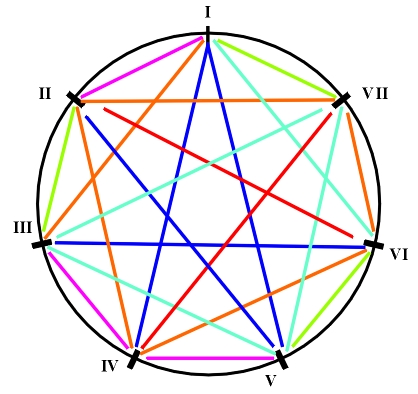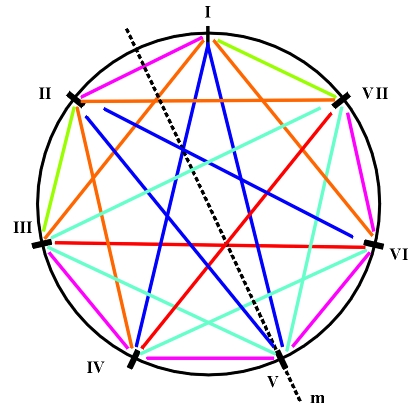|
Symmetry of fifth-chord coefficients of stability
The instability of a fifth-chord can be measured according to its similarity with the tritone triangle (Despi\' c, 1987). Based on this, we define the coefficient of instability n of a fifth-chord as the number of common tones it shares with a tritone triangle (i.e., as a coefficient of similarity of a fifth-chord in regard to tritone triangle). Vice versa, the coefficient of stability of a fifth-chord can be expressed by the formula s=3-n 1. Thus the stability coefficient of the tonic fifth-chord is 3, for the subdominant it is 2, and for a dominant it is 1. Consequently, the harmonic crescendo in the case of a major key has the form T-S-D and in the case of a minor key, the tritone occurs on the II degree, whose secondary function is s (s-tritone), which produces a harmonic crescendo T-D-S. The corresponding stability coefficient s can be found for any fifth-chord on any degree. For example, in the case of a major key, s(\textII)=1, as the fifth-chord which has 2 common tones with a tritone triangle is on the II degree (its instability coefficient is n=2, so s=1). In this manner we get the following table of stability coefficients s of the fifth chords that are positioned on different degrees of the major and minor key.
By using an analogous procedure it is possible to study the seventh-chord structure of natural scales. Of course, the transition to seventh-chords will not have any impact on harmonic functions. The table of the stability coefficient S=4-N of the seventh-chords is as follows:
Besides d-tritone on the VII degree, s-tritone appears on the II degree in the harmonic minor (Fig. 5.4)
(a)
(b) Figure 5.4 A diagram of the interval structure of the harmonic minor (a) and melodic minor (b). In the case of harmonic minor, by using the proposed procedure we get a diagram of the symmetry of interval structure. In this diagram an identification of complementary intervals has been made, i.e., the principle of minimal same-name intervals has been applied. In this diagram we can directly read the fifth-chord structure of the harmonic minor. The appearance of the tritone rectangle II-IV-VI-VII is evident at first sight. The instability of the fifth-chord on certain degrees is expressible in terms of their similarity with the tritone rectangle. As a result we get the following table of the stability coefficients of the fifth-chords:
In this table we note the complete stability of the tonic fifth-chord and the uniformity of the kinetic role of the subdominant and dominant function. As for the stability of the fifth-chord, the function of the VI degree is equally close to the tonic and subdominant function. However, the distinctive stability of the seventh-chord on the VI degree (S=3) prevails in favor of the tonic function. The stability coefficients of seventh-chord S are as follows:
Based on this table we can deduce that the harmonic crescendo in the case of the harmonic minor will have the form T-S-D. As opposed to the asymmetric interval structure of the harmonic minor (Fig. 5.4.a), the melodic minor has a symmetric interval structure (Fig. 5.4.b). There appears the axis of symmetry which contains the V degree and passes between the I and II degree. In regards to the symmetry of the fifth-chord structure, in the melodic minor the ambivalent symmetric function of the III degree stands out. Both the axis of symmetry for the VI and VII degree (dim-dim) and the axis of antisymmetry for the V and I, and the IV and II degree (maj-min) cross it simultaneously (Fig. 5.5). In the melodic minor the d-tritone on the VII degree represents a source of instability. The t-tritone in the diminished fifth-chord on the VI degree has an inferior role, so that when calculating the coefficient of stability it occurs only as a correctional factor on the VI degree. Accordingly, the coefficients of stability of fifth-chords s and the coefficients of stability of the seventh-chords S have the following values:
Based on this, the form of the harmonic crescendo is T-S-D.
Figure 5.5 The ambivalent symmetry function of the III degree of the melodic minor. 1For the tritone fifth-chord n equals 3. Consequently, its stability coefficient is s=0.
|





